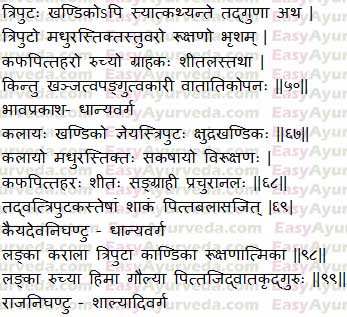By Dr Renita D’Souza
Botanical Name – Lathyrus sativus
Family – Leguminosae
Grasspea is highly nutritious legume crop. It is used for both culinary and medicinal purposes. Traditionally it is used to treat Scabies, eczema and allergy. It is the potential source of protein. Seed oil is considered as powerful cathartic.
Table of Contents
Names in Different Languages
Sanskrit Name – Triputa
English Name – Grass pea, blue sweet pea, chickling pea, chickling vetch, Indian pea, white pea, white vetch, Dogtooth pea
Kannada name – kesari bele, kesari togari
Hindi Name – Khesari dal, Khisari, Kasoor, Matar bhed
Bengali Name – Khesari, Kassur
Marathi Name – Laag, Lak
Punjabi Name – Kisari, Chural, Karas
Gujarati Name – Lang, Lung
Arabic Name – Ivul bakar, Khalaj
Pharsi Name – Masang
Tamil Name – kecari paruppu
Telugu Name – lamka
Malayalam Name – Kesarim
Qualities
Medicinal Qualities of Indian pea
Taste – sweet, bitter, astringent
Potency (virya) – cold
Ruksha – dry in nature
Ruchya – improves taste
Grahaka – absorbent
Vatati kopana – increases vata
Intake causes khanja – monoplegia and Pangu – paraplegia
Effect on Tridoshas
Balances kapha and pitta dosha
Part Used
Seeds, Seed oil, Leaves
Sanskrit Verse

Interaction with medicines, supplements
Can this be used while taking Homeopathic medicine?
Yes. This product does not react with homeopathic medicine.
Can
this medicine be continued while taking supplements like multivitamin tablets,
Omega 3 fatty acids etc?
Yes. Generally, this product goes well with most
of the dietary supplements. However, if you are taking more than one product
per day, please consult your doctor for an opinion.
With western
medicines
Seek your
doctor’s advice if you are taking this product along with other western
(allopathic / modern) medicines. Some Ayurvedic herbs can interact with modern
medicine.
If both Ayurvedic and allopathic medicines are advised together, then it is
best to take Allopathic medicine first, wait for 30 minutes and then take the
Ayurvedic medicine.
Morphology, Distribution
Morphology
Lathyrus sativus is a much-branched plant. Stems are slender, 25-60 cm long, quadrangular with winged margins. Leaves pinnate, opposite. Consists 1 – 4 leaflets, linear-lanceolate. Flowers are bright blue, reddish-purple, red, pink or white in color. Pods are oblong, flat, 2.5-4.5 cm long, contains up to 7 seeds. Seeds are wedge-shaped, white, pale green, grey or brown in color.
Distribution
Grass peas are cultivated in India, Nepal, Bangladesh and many parts of Africa.
Side Effects
Lathyrism – Excessive and prolonged consumption of Grass pea leads to neuron disorder, neurolathyrism. It is caused by degeneration of pyramidal tracts in the spinal cord. It is characterized by lack of strength in or inability to move the lower limbs. (related research)
Phytochemical
Grass pea contains alkaloids, carbohydrates, reducing sugar, flavonoids, terpenes, phenols, proteins and amino acids and tannins
Research
CNS depressant, Analgesic, Antipyretic activity – A study conducted to evaluate phytochemical and pharmacological activities of methanolic plant extract of Lathyrus sativus L. seeds have concluded that the plant extract possess significant CNS depressant, analgesic and antipyretic activity.
Sanskrit Synonyms
Triputa, Khandika, Langa
Classical Categorization
Bhavaprakasha Nighantu – Dhanya varga
Kaiyadeva Nighantu – Dhanya varga
Raja Nighantu – Shalyadi varga
Scientific Classification
Kingdom – Plantae
Order – Fabales
Family – Fabaceae
Subfamily – Faboideae
Tribe – Vicieae
Genus – Lathyrus
Species – L. sativus
Click to Consult Dr Renita D’Souza











2 comments
Dr Surendra Barpete
It is excellent information regarding grasspea/Kheasri.
Dr J V Hebbar MD(Ayu)Author
Thanks Dr Surendra.